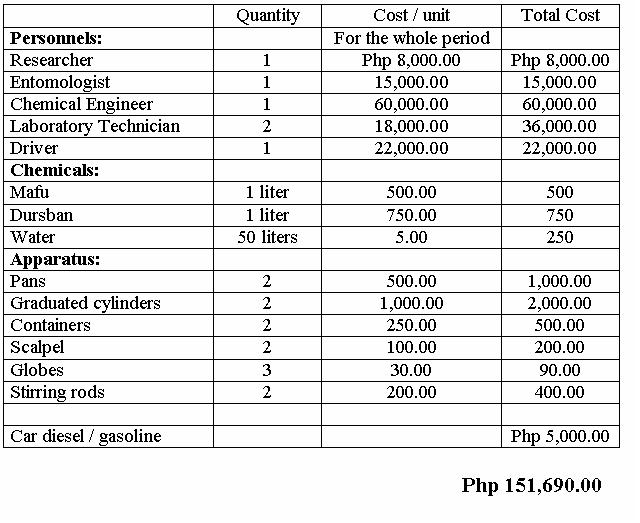* This research proposal is prepared by Engr. Janet S. Crisostomo as school requirement
A. Introduction
For many years, concrete has been used as a construction material in building structures. However, the use of wood cannot be avoided for its countless variety of purposes such as ceilings, furniture, cabinet doors and windows. Though, the cost of wood is very high, its beauty and durability is a priceless thing. Its beauty though may just end up devastated due to termite invasion. These termites are extremely destructive because they tunnel their way to wooden structures, into which they burrow to obtain food. Given enough time, they will feed on the wood until nothing is left but a shell, which cause collapse or damage of the wooden structure of the house. Today, termite proofing and control has been widely used. This is done by injecting the solution by the use of soil injector at 12” interval along the perimeter of the building, and under the slab, sub-slab injector is used. Treatment is done until the queen termite is exterminated.
The use of the said method is not effective in most areas because different species of termites need different treatment method. Also for the fact that after the royal pair dies, nymphs at a particular stage in their molting cycle rapidly develop reproductive organs and become fertile. A similar process appears to operate n maintaining the required number of soldiers in the community. A new colony is then established by a male and female who become primary reproductive. The new colony will again enter the house and damage all wooden structure.
B. The Problem
What chemical solutions will double the effect of the ordinary solution (5-year guarantee) in controlling termites, for only one application?
C. Objectives
The aim of this research is to be able to produce a more effective chemical solution in controlling termites, which will double the guarantee of an ordinary method (5-year guarantee) used, ensuring a one-application treatment.
D. Importance of the Study
Through this study, the chemical solutions that will double the effect of the ordinary solution may be formulated. This will give a ten-year guarantee for the preservation of all wooden part of the structure.
E. Scope and Delimitation of the Study
Investigation may require the following:
1. Different species of termites.
2. Type of soil most termites exist.
3. Type of chemical to be formulated.
4. Treatment to be used.
F. Methods of Research to be Used
Methodology
1. Study all types of species of termites.
a. Knowing the mode and rate of reproduction in different species.
b. Determining the weaknesses of the termites.
c. Knowing the type of soil most termites exist.
2. Formulating the new solution.
Chemical needed:
Mafu – Knockdown power
Dursban – residue
Water
The ordinary solution gives a proportion of 1 liter Dursban: 1 liter Mafu: 100 liter water. To be able to double the effect of this solution, the new proportion will be doubled as such, 1 liter Dursban: 1 liter Mafu: 50 liter water.
3. Experimentation / Observation
Two specimens (timber) will be used. One, applying the ordinary solution and the other is the formulated solution.
Procedures:
- Place a timber 4 feet in length on a large pan.
- Put Highly destructive termites approximately 100 pieces on a timber. (Subterranean termite or Drywood termite can be used if Highly destructive termite is not available)
- Allowing it to feed on wood until almost 20% of wood is damage.
- Apply 2 liters of ordinary chemical solution all over the surface of the timber.
- Observe, and record the time when all termites die after the application of the solution.
- After a week, place another termite around the damaged timber. Observe if these termites can come near the timber.
- Observe and record the number of days the termites will enter into the damaged timber after application of the solution. This relates to the length of solution’s effect to the timber.
- Another timber is to be used applying the new solution. The same procedure is to be done in testing this solution with the same amount as the ordinary solution.
- Compare the length of effects of the two solutions to the timber. Compute the ratio of new solution and ordinary solution. If the computed ratio is more than or about two, then this makes doubling the effect of the new solution over the ordinary solution.
G. Schedule and Resources
1. Schedule : (Gantt Chart)
2. Personnel:
Researcher (1)
Entomologist (1)
Chemical Engineer (1)
Laboratory technician (2)
Driver (1)
3. Materials:
Different species of termites
Highly-destructive termites
Subterranean termites
Drywood termites
Other species
Timber (2 pcs.)
Chemicals
Mafu (1 liter)
Dursban (1 liter)
Water (50 liters)
4. Apparatus and Equipments:
Pans
Containers
Graduated cylinder (1000 ml)
Scalpels
Globes
Stirring rods
H. Budget

